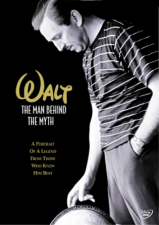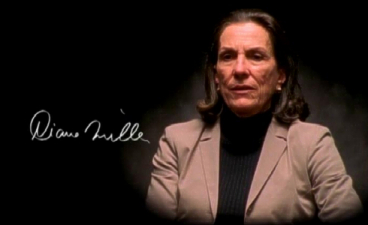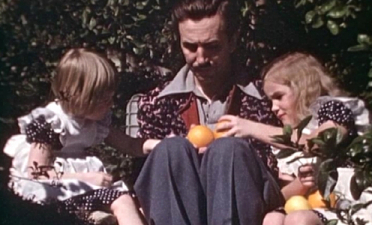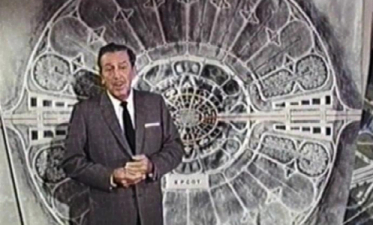 Walt Disney was a very special person indeed. Known throughout the world for his animated films, live-action features, television programs, the theme parks and his beloved cartoon character creations, Walt was also a technical innovator, pushing ahead with pioneering uses of storyboards, sound (and later stereo surround), color, widescreen, 3D and special effects, as well as animatronics – “real” animated robot characters.
Walt Disney was a very special person indeed. Known throughout the world for his animated films, live-action features, television programs, the theme parks and his beloved cartoon character creations, Walt was also a technical innovator, pushing ahead with pioneering uses of storyboards, sound (and later stereo surround), color, widescreen, 3D and special effects, as well as animatronics – “real” animated robot characters.
On top of all this, he was also a loving husband to wife Lillian, and Dad to his daughters Diane and Sharon. Born in 1933, Diane was joined just a few years later by adopted sister Sharon, and the two grew on the sets of their Dad’s films and had sneak previews of projects in development. After Walt’s passing, Sharon remained a very private person, while Diane continued to be involved in the family business by way of marriage to Ron Miller, who produced many of the Studio’s wonderful pictures in the 1970s and early 80s. More recently, she has championed Walt on the web, with the Walt Disney Family Museum, which seeks to preserve the life, work and philosophy of her father.
In 2001, in recognition of Walt’s centenary year, both studio and family pooled resources to produce Walt: The Man Behind The Myth, a wonderful 2-hour biographical documentary that celebrates Walt the man, and Disney, his company, which took a while but is now available in wide release on DVD. After a harrowing journey through red-lights and rush hour traffic to make my appointment, I had an opportunity to talk to Diane about Walt’s life at home and at the Studio, and find out more about the Dad behind the myth…

Animated Views: Thanks for taking the time out to talk with us, and congratulations on The Man Behind The Myth film, I really enjoyed it.
Diane Disney Miller: Oh, thank you.
AV: I have to say it is a privilege to talk to you because I am a huge Walt fan in both the projects he created and his way of life, and growing up he was a real inspiration to me because most of what I learnt was from his films. He was known throughout the world as Uncle Walt, so how did you feel growing up – was there a sense that you were sharing him with the rest of the world?
DDM: I think my sister and I didn’t feel that way when we were very young but as we each got a little older I think we began to, and I kind of resented it although he was still ours. But I resented the fact that it was obvious that a lot of people our age felt that they owned him as much as we did, so yes I did feel a little of that later.
AV: How was life at home split with life at the studio for Walt and how did he cope with dealing with those two different sides of his life?
DDM: Well when he was home, he was home, you know? Home was important to him, and so was his family, and they always had been. But he was with Mom and he was happy to be home. They were wonderful companions, sweethearts forever and I learnt later from his sister, Aunt Ruth, that he wanted a big family. He told her he was going to have ten kids and let them do anything they wanted to do! He only had the two of us, but our home was a wonderful place, almost like anyone else’s home, I think. Dad would come home from work, he would have dinner. We’d do our homework, except that after a certain point in time, I think it was about in the late forties, he put a projection room in, so very often we’d see a movie after dinner. So that was rather unusual. I think he did it when he started Song Of The South and we would see dailies, as he would see them at home rather than at the studio. And I think that’s one reason he built the room, when he was getting into more live action movies.

AV: And what was it like at home when he put his own money into projects, for instance like DisneyLand?
DDM: Oh he always did have his own money and we always lived well, but I realise now that there were times when it was very difficult, I think it was during the War, after Fantasia and all that [the 1941 Studio strike], and I think he felt it. But he never lost confidence in himself and his disappointments were not devastating to him. He quickly would go on, he talked about it openly. To get DisneyLand started he borrowed on his life insurance. They had just built a second home down in Palm Springs and he banked on that, because he had great confidence that it was going to work. If it hadn’t worked things would have been a lot different!
AV: Quite throughout his career Walt took major gambles and luckily they all paid off, which is some thing I find very inspiring.
DDM: But you know his own hard work and energy was still a driving force in the end, and I think that he had such confidence in himself and in what he envisioned.
AV: And when it was finally completed, how did you feel going to DisneyLand for the first time?
DDM: Oh, let’s see, I was the mother of one little boy, and my husband was in the army, and I’d come down for their [Walt and Lilly’s] anniversary party the night before the opening of DisneyLand. They had it on the big Mark Twain riverboat with all their friends, and it was a wonderful party. Of course I’d been down, walking around and seeing it as it was built over the couple of years that it took, and first of all I thought that it was wonderful, but I was an adult with a small child of my own, but I was still pleased with it.

AV: Going back to the documentary I noticed that the version on the DVD is very different to the VHS cut. Who pushed for the DVD release, and why is the cut different?
DDM: Well, we were able to put more in it. I think that’s what so wonderful about the DVD. The VHS was frustrating because we only had little soundbites from all the people that we interviewed and we couldn’t include everybody that I wanted to be part of it, and the DVD gave us the space do to that.
AV: And what kind of control did you have over the final version?
DDM: I think we pretty well determined what we wanted to have on it and what we thought was important. I know I was very emphatic that we didn’t have Mary Costa or Ilene Woods on the VHS and I thought their interviews were wonderful and you know my Dad’s life with those films was so important and so lovely, and they brought so much to it.
AV: There’s a great deal of archive footage in the documentary, a lot of which is shown widely for the first time. How much were you conscious of showing to the public and are there any other clips that could have been included that you didn’t want to show?
DDM: No, I think we included just about as much as we could. I would love to show more film of my parents when they were younger, my Dad trying to ice-skate, things like that, because in it you see the influence of Charlie Chaplin, Harold Lloyd and Mickey Mouse! It’s all in my Dad right there! He was quite a Chaplin fan at the time, from the time in his childhood and I think Mickey showed a lot of influence of those famous silent films that he was in.
AV: Nowadays Walt’s nephew Roy E. Disney runs the animation department of the Studio, as well as being an executive. How much involvement do you have as a family with Walt’s company?
DDM: We have no involvement at all. The only involvement was that we contracted with the company and they produced and distributed the CD-Roms [the 1998 Intimate History disc] for us and it didn’t do very well, but with the film, ABC’s buying it, I was very pleased that they did it, it seemed so right and it aired once on the Disney show a year ago.

AV: And how do you think Walt would find what The Walt Disney Company is today; it’s grown to such massive proportions.
DDM: Yes it has grown, it’s huge, but he was going in other directions. At the end of his life, without knowing it was the end of his life, Epcot was what he was looking at; looking beyond entertainment, but in a sense it was. He always used to say he felt that school should not be boring – school should be entertainment, and he felt that somehow engaging people in a stimulating and pleasant way was a way to achieve everything, even selling progress to people and industry. He really felt that at that point in his life that he knew that he had the support that he lacked in earlier years. He didn’t have to go and plead with the bankers to get them to give him money to continue a film, or pestering my Uncle Roy [O. Disney, Walt’s brother] – he was the one who was charged with doing that and did it so well – but he was really at a point in his life where he could have gotten the support from just about anybody to do anything! He created an art school, the Institute Of The Arts, and Epcot, which he thought was a wonderful way for industry, what they wanted to do, to showcase the future and the products of the future, so that the public could be excited about it and could accept it.
AV: Walt himself did obviously push forward with embracing new technology and for instance, with computer animated films, a lot of people are saying “oh, it’s not 2D, and it’s not cel animation, Walt wouldn’t like that”. I’m with the crowd who believes that he would have been open to that technology way before it actually took off with Toy Story and films like that. He was interested in computers in the 60s, wasn’t he?
DDM: I don’t know about computer animation, but I do know that the Mr Lincoln that they did for the World’s Fair was audio-animatronic figures – that was computers, and the computer was huge, rather it was a large room, and it made Mr Lincoln stand up and sit down, and talk and all that, so that’s the only use that I’m aware of. I do know that they used the Xerox process in Dalmatians and he was not happy with that at first and I think that caused Ken Anderson a great amount of grief, but he later said “No, I like it”. I loved it, I loved the rough-lines.

AV: For me, The Jungle Book is such a vibrant and lively film because of that Xerox process; I think the animation really springs to life in that film.
DDM: That was in the making when he died. That’s about the last film that has any imprint of Dad on it.
AV: And there’s a Jungle Book 2 coming out in February. Walt famously once said “you can’t top pigs with pigs” regarding a sequel to the Three Little Pigs. So what do you think he might have felt about the sequels the Studio is currently releasing; there was another Peter Pan last year, and they have a Dumbo and a Bambi lined up…
DDM: I don’t think he would have done that. I really don’t.
AV: The official Disney website hosts The Walt Disney Family Museum on the internet. So how does that work with the Studio, do you actually maintain that yourselves?
DDM: Well Richard and Katherine Greene maintain that, but the Studio gave us the name Walt-Disney-dot-com. And I thought that that was quite lovely. It runs under their portal, they host it, we are a part of their website.
AV: It’s nice that the company does look back and recognise who Walt was, who he is, and how important he is, and that’s something that you don’t get with, for instance, the Warner Brothers or any of the other companies. But he is such a part and parcel of what the company is even now that it just feels “right” to have Walt around. Out of all of his creations, be it animation, live-action, theme parks, or anything else he was involved with, what is your favorite?
DDM: That I can’t say! I didn’t like everything of course, but I loved so many of them, and really loved them, and kind of knew them in my Dad’s mind in a sense that they were developing then. I could say Mary Poppins, I thought that was a wonderful, wonderful movie, but as far as animation goes…oh, Snow White, Pinocchio, Dumbo, Bambi – there are so many! Dalmatians, I really loved that, all of them! Cinderella, Sleeping Beauty…
AV: You’re like me, you can’t pick a favorite!
DDM: No! And this is from all of them, you know. Characters, moments. It’s just, I think, the whole thing.
AV: And how do you find the current crop of Disney films, like Beauty And The Beast and The Lion King?
DDM: You know what I like, what I really love that’s been done is taking them on to Broadway, on to the stage and combining some of that and doing beautiful stage productions, because I think that live theater needs some support, and I think that these Disney productions have been so popular and so beautifully done.
AV: I hear they’re soon to be joined by The Little Mermaid, which should also be a sight to see.
DDM: That should be interesting.
Animated Views: Well, I think our time here is done, so can I just thank you again – it’s been a real pleasure to talk to you!
Diane Disney Miller: Thank you, Ben.

Read our full review right here!
To find out about Walt Disney, and hear more from Diane, visit The Walt Disney Family Museum at WaltDisney.com.


